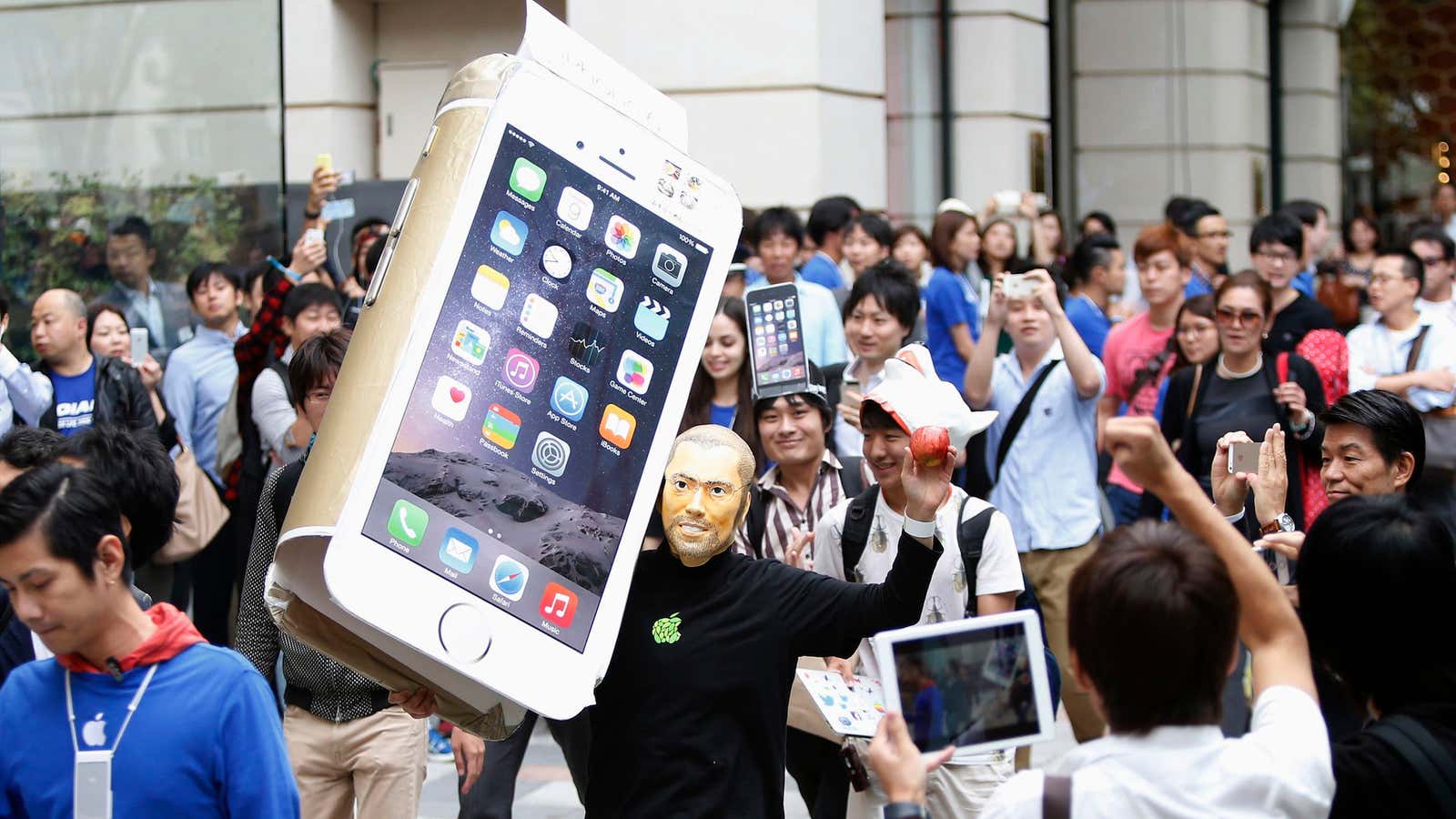This weekend, the iPhone 6 and 6 Plus went on sale to record pre-orders and insanely long queues. Sure, there’s pent up demand from the public, which has been clamoring for bigger devices for years.
But much of the rush for the new huge iPhones comes not just from the broader public, but from hardcore Apple fanatics. And the Apple faithful don’t just want the 4.7-inch iPhone 6. They’re after the 5.5-inch iPhone 6 Plus, too.
Why are the true believers so enthusiastically jumping on the bandwagon, after holding out so long against the tide of larger phones?
The ungenerous answer is that Apple fans will buy anything Apple makes. And there is, perhaps, some truth in that, as we’ve seen this before. In 2011, Samsung started releasing “phablets,” including the 5.3-inch Galaxy Note with an accompanying stylus. All of which brought cries of tastelessness from Apple fanboys, especially as the iPhone 4S was released and stubbornly stuck to the original screen size of 3.5 inches. At the time, the Apple blogger John Gruber said on his site, Daring Fireball:
Apple decided on the optimal size for an iPhone display back in 2006. If they thought 4-inches was better, overall, as the one true size for the iPhone display, then the original iPhone would have had a 4-inch display.
Call it the Church of Apple. Steve Jobs once called big phones Hummers (like the cars) and said that no-one was going to buy them. (He was sitting next to the current CEO, Tim Cook, when he said that.) Only a year after the iPhone 4S, the iPhone 5 was released with a 4-inch display and it sold like hotcakes. The Apple fans bought it and loved it. And the same thing is happening again. So what gives?
Marco Arment, the creator of Instapaper, suggests that Apple fans were only ”partially just flat-out wrong,” but mainly failed to see the technological advances that would make big phones lighter and more useful. Which is all a nice way of saying the battery is much better. “Big-screened phones were mediocre in 2011, but we failed to see that they wouldn’t always be,” he wrote. “People holding Galaxy Notes up to their faces to make phone calls looked ridiculous in 2011. Today, making a phone call in public on a huge phone is commonplace, and how often do you make phone calls in public anymore?”
Gruber upgraded to an iPhone 6. ”One week in and I’m still unsure about the size of the iPhone 6 relative to that of my iPhone 5S, but I’m very sure about the size of the 5.5-inch iPhone 6 Plus: it’s too big for my taste,” he said in his review of the phones. He recalled an incident in a Verizon store two years ago where a tiny woman wanted a Galaxy S III or even a Galaxy Note because she didn’t want a tablet and wanted to use her phone for everything. She was not alone in her decision-making. Demand for phablets is the fastest growing segment of mobile devices.
So much so that Dan Frakes, the former senior editor of Macworld, decided to get the biggest iPhone ever made. ”I think that in the past, we truly believed that the idea of a huge phone was silly,” Frakes wrote. “But many of us, for a lack of better phrasing, have evolved—and so has the hardware.” Frakes previously carried his iPhone 5S and the iPad Mini to do all the things he wanted to do—like read and watch movies. “It wasn’t until I stopped thinking of my iPhone as a phone, and started thinking of it as a computing device, that I warmed to the idea of a honking-big smartphone,” he said. “My hope with the iPhone 6 Plus is that I’ll find myself carrying a second device much less frequently.”
The time for calling the iPhone 6 a “sleek, sophisticated rounded rectangle” compared to the Galaxy S5’s “bulky, hideous rounded rectangle,” as The Onion put it, has passed. We’re all going to use bigger smartphones. At least for now, the taste wars are over.
